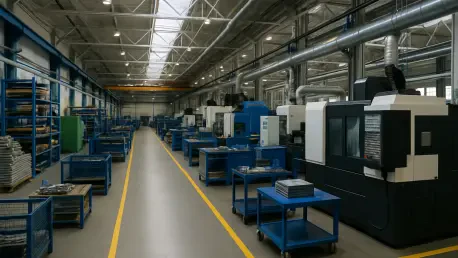The contract development and manufacturing organization (CDMO) sector stands at a critical juncture as global economic policies, particularly U.S. tariffs, cast a shadow over various industries. With tariffs often designed to protect domestic markets, their ripple effects could reshape supply chains and competitive landscapes for CDMOs, which are integral to the biopharma ecosystem through outsourced manufacturing and development services. A recent analysis by a leading credit ratings agency suggests that while immediate disruptions may be minimal, the long-term implications of sustained tariffs could challenge the sector’s growth trajectory. This raises pivotal questions about how CDMOs can adapt to potential shifts in demand, capacity constraints, and international competition. As biopharma companies increasingly rely on these organizations for specialized services, understanding the nuanced impact of tariffs becomes essential for stakeholders navigating an evolving market.
Economic Policies and Sector Stability
Tariff Resilience in the Short Term
The CDMO sector appears to exhibit a notable degree of resilience against the immediate effects of U.S. tariffs, largely due to its strong credit profiles bolstered by predictable contractual revenues. Many firms benefit from price and volume protections embedded in their agreements, which shield them from sudden economic shocks. Additionally, the inherent stability of the biopharma industry, where CDMOs play a vital role, provides a buffer against broader market fluctuations. For U.S.-based CDMOs, tariffs might even present an opportunity to secure new contracts as biopharma companies look to reduce reliance on foreign manufacturing. This shift could enhance domestic competitiveness, positioning these firms favorably in a tariff-driven landscape. However, while short-term impacts seem limited, the sector must remain vigilant about how prolonged tariff policies could alter client priorities and sourcing strategies over time, potentially reshaping the competitive dynamics in unexpected ways.
Long-Term Risks of Tariff Pressures
While the near-term outlook for CDMOs under U.S. tariff policies seems stable, extended periods of high tariffs could introduce significant challenges, particularly related to capacity and scalability. Domestic firms may struggle to meet heightened demand if biopharma companies pivot away from international suppliers, potentially leading to bottlenecks in production and service delivery. Smaller or less diversified CDMOs face heightened risks, as their limited geographic reach or specialized service offerings could hinder adaptability to sudden market shifts. The strain on infrastructure and resources might expose vulnerabilities, especially for companies lacking the capital to expand operations swiftly. As tariffs reshape global supply chains, the pressure to maintain cost competitiveness while scaling capabilities could test the resilience of even well-established players, necessitating strategic foresight to mitigate potential disruptions in the evolving economic environment.
Industry Trends and Strategic Adaptations
Growing Demand for Specialized Services
A defining trend in the CDMO sector is the increasing shift toward biologics and advanced therapies, driven by biopharma companies seeking to optimize resources and accelerate development timelines. This growing reliance on outsourcing has fueled demand for high-value services such as highly potent active pharmaceutical ingredients (HPAPIs) and antibody-drug conjugates (ADCs), which require sophisticated expertise. Unlike traditional markets for active pharmaceutical ingredients (APIs), these specialized offerings often come with higher margins but also intensified competition. For CDMOs, this presents an opportunity to carve out niche roles within the biopharma supply chain, enhancing their value proposition. Yet, the transition to these complex services demands substantial investment in technology and talent, underscoring the need for firms to balance innovation with operational efficiency to meet client expectations in a rapidly evolving therapeutic landscape.
Challenges and Competitive Dynamics
Despite the promising growth in specialized services, the CDMO sector faces significant hurdles that could temper its trajectory amid tariff-related shifts. The demand for highly skilled labor, including scientists and project managers, remains a persistent challenge, compounded by rising costs and staff turnover that can disrupt operations. Additionally, the sector’s fortunes are closely tied to biopharma research and development (R&D) investments, meaning any slowdown in drug pipelines could directly impact revenue streams. In such scenarios, cost-efficient regions like Asia-Pacific might gain an edge, posing competitive pressures for U.S.-based firms already grappling with tariff-induced constraints. Navigating these challenges requires CDMOs to adopt flexible strategies, whether through targeted hiring initiatives or partnerships that bolster operational resilience against both domestic policy shifts and global market trends.
Strategic Pathways for Growth
Looking back, the CDMO sector demonstrated remarkable adaptability in responding to early signals of tariff impacts by exploring diverse growth strategies. Many companies weighed the merits of organic expansion versus inorganic approaches like mergers to either specialize in specific dosage forms or broaden their service portfolios as comprehensive solution providers. This strategic flexibility proved crucial in addressing evolving market demands while maintaining a competitive stance. Reflecting on past actions, it became evident that balancing specialization with diversification was key to sustaining growth. Moving forward, CDMOs are encouraged to prioritize investments in capacity and talent to address potential bottlenecks. Embracing technological advancements and forging strategic alliances also emerge as actionable steps to navigate future uncertainties, ensuring that firms remain agile in a landscape shaped by economic policies and industry innovation.









